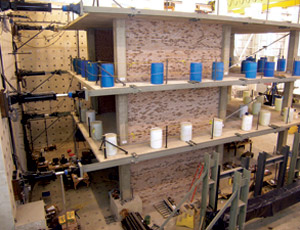A relatively simple formula can predict how well buildings withstand earthquakes, according to lab work and research in Haiti by Purdue University. The studies suggest how to strengthen existing buildings at a low cost and how to make new buildings damage-resistant.

After the January 2010 earthquake, Purdue professors Santiago Pujol and Ayhan Irfanoglu, both civil engineers, surveyed 170 buildings in Haiti. They concentrated on two- to five-story buildings that were made with reinforced-concrete exteriors.
About 40% of the buildings were heavily damaged. The proposed index would have identified about 90% of the heavily damaged buildings as vulnerable if it had been in use before the quake.
“The index tells you that a building that has long spans, small cross-sectional columns and few walls is more vulnerable to earthquake damage than one that doesn’t,” says Irfanoglu. The index compares the combined cross-section areas of all the ground-story columns and walls with the building’s total usable floor area.
Captive columns—vertical members that have partial-height walls connecting them—are more vulnerable to damage than columns connected by full-height walls, they note. About 60% of the 170 buildings they surveyed in Haiti had captive columns.
The index was developed in Japan in the 1960s and has been adapted in Italy, Turkey, Chile and other countries. In each case, the index needs to be adjusted for local conditions, construction techniques and materials.
The system could be used immediately in Haiti to find the most vulnerable buildings and prioritize which to repair first, the Purdue engineers say. Buildings could be strengthened by increasing column size, adding infill walls, eliminating captive columns and replacing some hollow-block walls with solid concrete or brick. They note, however, that improvements will not make buildings earthquake-proof, just more earthquake-resistant.
“This is not the ideal or most sophisticated solution engineering can provide,” says Pujol, “but it is an improvement that’s affordable and something people can do with their own hands now.”
At least one seismic expert thinks the index is not the best way to predict failure. “Although captive columns are dangerous, focusing on them is an oversimplification,” says H. Kit Miyamoto, a West Sacramento, Calif.-based seismic engineering consultant. “Soft subsoils are more dangerous by far.”
Pujol and Irfanoglu put their observations and theory to the test by building and then shaking a three-story building in a laboratory. Pujol and Irfanoglu presented their findings to officials from the National Science Foundation’s Rapid Response Research program this fall.



Post a comment to this article
Report Abusive Comment